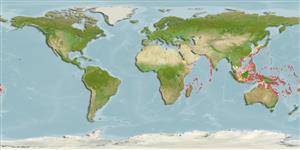Holothuria lessoni Massin, Uthicke, Purcell, Rowe & Samyn, 2009
Golden sandfish| Native range | All suitable habitat | Point map | Year 2050 |

|
| This map was computer-generated and has not yet been reviewed. |
| Holothuria lessoni AquaMaps Data sources: GBIF OBIS |
Classification / Names Common names | Synonyms | CoL | ITIS | WoRMS
Holothuroidea | Holothuriida | Holothuriidae
Environment: milieu / climate zone / depth range / distribution range Ecology
Reef-associated; depth range 0 - 25 m (Ref. 108901), usually 0 - 10 m (Ref. 108901). Tropical
Distribution Countries | FAO areas | Ecosystems | Occurrences | Introductions
Indo-West Pacific: East Africa to Papua New Guinea and Australia.
Length at first maturity / Size / Weight / Age
Maturity: Lm ? range ? - ? cm Max length : 48.0 cm TL male/unsexed; (Ref. 80470); common length : 35.0 cm TL male/unsexed; (Ref. 80470); max. published weight: 2.8 kg (Ref. 122)
Life cycle and mating behavior Maturity | Reproduction | Spawning | Eggs | Fecundity | Larvae
Main reference
References | Coordinator | Collaborators
Massin, C., S. Uthicke, S.W. Purcell, F.W.E. Rowe and Y. Samyn 2009 Taxonomy of the heavily exploited Indo-Pacific sandfish complex (Echinodermata: Holothuriidae). Zoological Journal of the Linnean Society 155:40-59. (Ref. 80470)
IUCN Red List Status
(Ref. 130435: Version 2025-1)
CITES status (Ref. 108899)
CMS (Ref. 116361)
Threat to humans
Human uses
Fisheries: highly commercial
FAO - Fisheries: landings | FishSource |
Tools
More information
Diet composition
Food consumption
Predators
Max. ages / sizes
Length-weight rel.
Length-length rel.
Length-frequencies
Mass conversion
Abundance
Internet sources
BHL | BOLD Systems | CISTI | DiscoverLife | FAO(Fisheries: ; publication : search) | Fishipedia | GenBank (genome, nucleotide) | GloBI | Gomexsi | Google Books | Google Scholar | Google | PubMed | Tree of Life | Wikipedia (Go, Search) | Zoological Record



